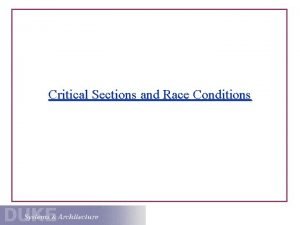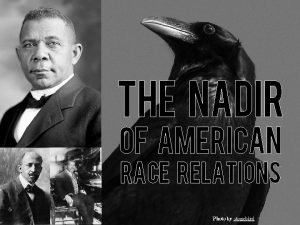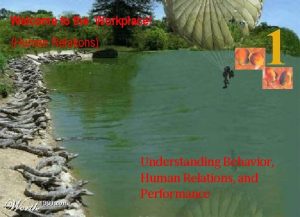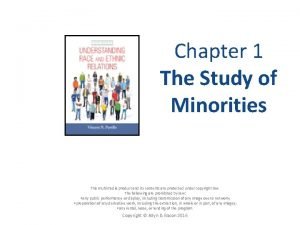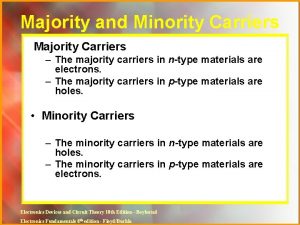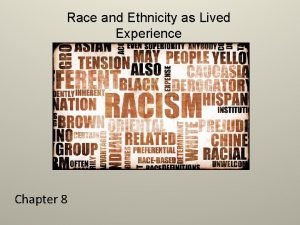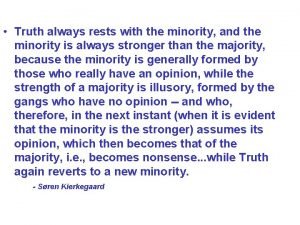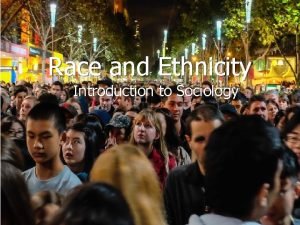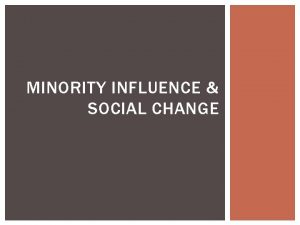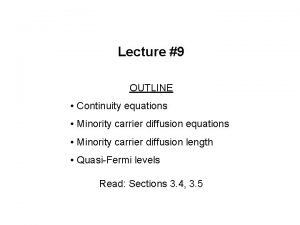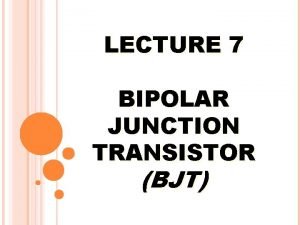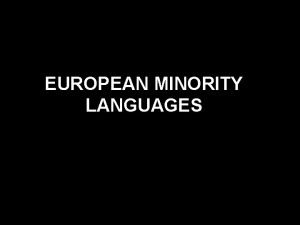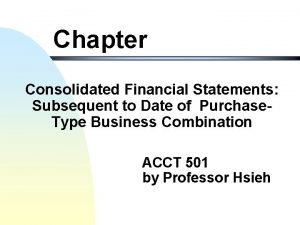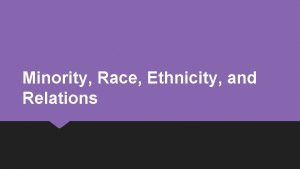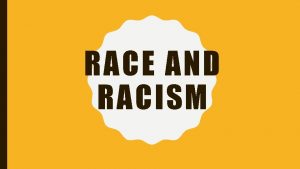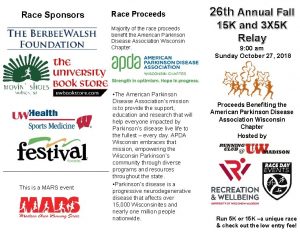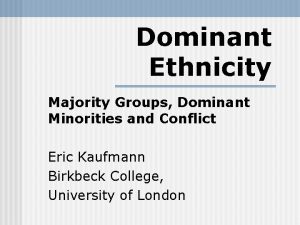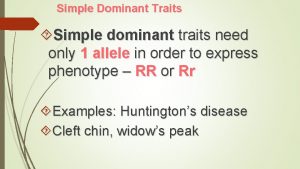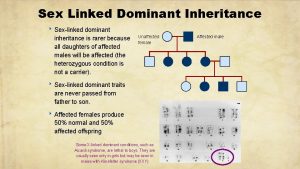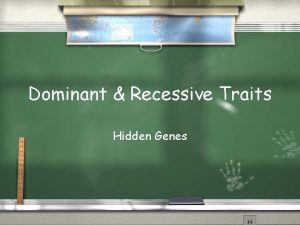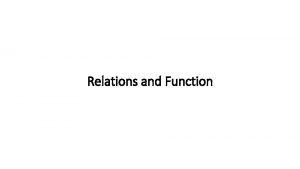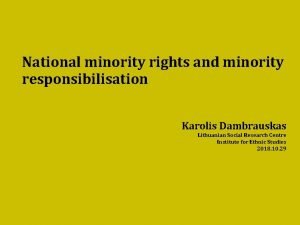Chapter 6 Dominant Minority Relations Understanding Race and




















- Slides: 20

Chapter 6 Dominant. Minority Relations Understanding Race and Ethnic Relations 5 th Edition This multimedia product and its contents are protected under copyright law. The following are prohibited by law: nany public performance or display, including transmission of any image over a network; npreparation of any derivative work, including the extraction, in whole or in part, of any images; nany rental, lease, or lending of the program. Copyright © Allyn & Bacon 2016

Minority-Group Relations n Ethnic-Group Identity n n Exists when individuals choose to emphasize cultural or national ties as the basis for their primary social interactions and sense of self Part of the growing-up process for minorities often involves the existence of a dual identity: one in the larger society and another within the person’s own group.

Minority Group Responses Avoidance Deviance Defiance Acceptance

Minority Group Responses Avoidance: Seek to leave problems behind by migrating or turning inward to group for social and economic activities. Deviance: Occurs in societies where laws impose moral standards on behavior of other groups. Defiance: Openly challenging dominant group’s discriminatory behavior as subordinate gains in cohesion, as well as in economic and political power. Acceptance: Accede to situation through subtle rationalizations, personal or economic security, and/or false consciousness.

Consequences of Minority-Group Status n Negative Self-Image The result of social conditioning, differential treatment, or both, causing people or groups to believe themselves inferior n Can cause people to accept their fate passively n Can encourage personal shame for possessing undesired qualities or antipathy toward other members of the group for possessing them n

The Vicious Circle n n Sometimes the relationship between prejudice and discrimination is circular. Gunnar Myrdal referred to this pattern as cumulative causation Which is a vicious circle in which prejudice and discrimination perpetuate each other. n The pattern of expectation and reaction may produce desirable or undesirable results n

Source: http: //www 94. homepage. villanova. edu/peter. knapp/Icout. htm

Marginality n n Minority group members sometimes find themselves caught in a conflict between their own identity and values and the necessity to behave in a certain way to gain acceptance by the dominant group. Marginality usually arises when a member of a minority group is passing through a transitional period.

Marginality n n n Marginality is an example of culture conflict cased primarily be the class of values within the individual. Marginality is a one- or two- generation phenomenon. After that, members of the minority group either have assimilated or have formed a distinctive subculture and are no longer caught between two worlds.

Middleman Minorities n The Model of Middleman Minorities Suggested by Hubert Blalock n Based on a dominant-subordinate stratification system, places middleman minorities in an intermediate rather than low-status position. n n Middleman minorities often serve as buffers and experience hostility and conflict from above and below.

Dominant-Group Responses n Legislative Controls If the influx of racial and ethnic groups appears to the dominant group to be too great for a country to absorb, or if prejudicial fears prevail, the nation may enact measures to regulate or restrict their entry. n To maintain a paternalistic social system, the dominant group frequently restricts the subordinate group’s education and voting opportunities n

Dominant-Group Responses n Segregation n Spatial segregation n n The physical separation of a minority people from the rest of society Social segregation n Involves confining participation in social, service, political and other types of activities to members of the in-group

Dominant-Group Responses n n Mass expulsion is an effort to drive out a group that is seen as a social problem rather than attempting to resolve the problem cooperatively. It depends in part on how sensitive the country is to world opinion, which in turn is related to the country’s economic dependence on other nations.

Dominant-Group Responses n Xenophobia n n n The undue fear of or contempt for strangers or foreigners This almost hysterical response begins with ethnocentric views. Ethnocentrism encourages the creation of negative stereotypes that can escalate through some catalyst into a highly emotional reaction.

Dominant-Group Responses n Annihilation n n Killing all the men, women, and children of a particular group Annihilation goes back to ancient times. In modern times, various countries have used extermination as a means of solving the so-called race problem. Annihilation sometimes occurs unintentionally.

Figure 6. 1 Lynchings in the United States Since 1882

Dominant-Group Responses n Hate Crimes n n n Commonly defined as any criminal offense against a person or property that is motivated in whole or in part by the offender’s bias against a race, religion, ethnic/national origin, group, or sexual orientation Many states have passed laws mandating severe punishments for persons convicted of these crimes Federal law permits federal prosecution of a hate crime as a civil rights violation is the assailant intended to prevent the victim from exercising a “federally protected right”.

Figure 6. 2 Hate Groups in the United States in 2003

Table 6. 1 Bias Motivation of Hate-Crime Incidents in 2003, by Percentage

Exploitation n Based on her split labor market theory, Bonacich argues that ethnic antagonism results from the combination of economic exploitation by employers and economic competition between two or more groups of laborers that produces wage differential for labor.
 Dominant minority
Dominant minority Reaction and impulse turbine difference
Reaction and impulse turbine difference Dam spillway types
Dam spillway types Data race vs race condition
Data race vs race condition Nadir of race relations
Nadir of race relations Employee relations in public relations
Employee relations in public relations Understanding human relations
Understanding human relations Minority ch 1
Minority ch 1 Difference between majority and minority carriers
Difference between majority and minority carriers Minority dialect
Minority dialect Doctoral initiative on minority attrition and completion
Doctoral initiative on minority attrition and completion Chapter 8: race and ethnicity as lived experience
Chapter 8: race and ethnicity as lived experience Truth always rests with the minority
Truth always rests with the minority Define minority group
Define minority group Behaviours that enable a minority to influence a majority
Behaviours that enable a minority to influence a majority Define minority group
Define minority group Continuity equation in semiconductor
Continuity equation in semiconductor Npn and pnp transistor difference
Npn and pnp transistor difference Minority language meaning
Minority language meaning Examples of control accounts
Examples of control accounts Minority interest example
Minority interest example



